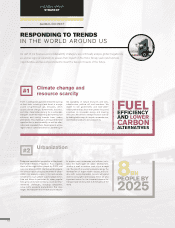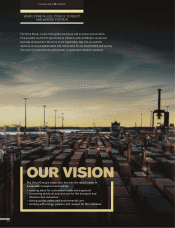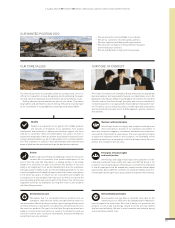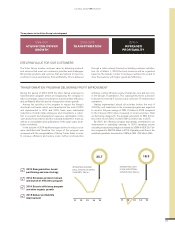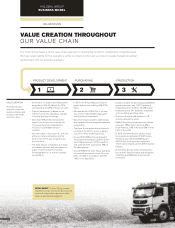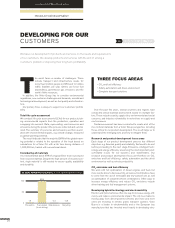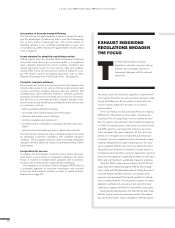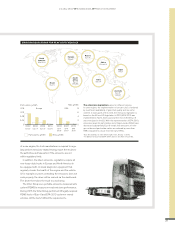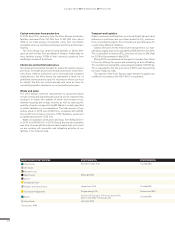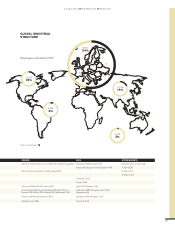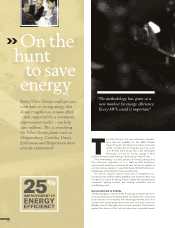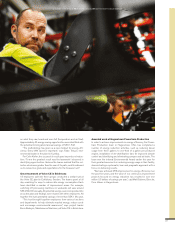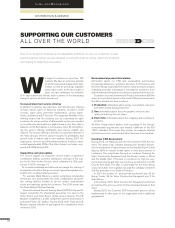Volvo 2015 Annual Report Download - page 30
Download and view the complete annual report
Please find page 30 of the 2015 Volvo annual report below. You can navigate through the pages in the report by either clicking on the pages listed below, or by using the keyword search tool below to find specific information within the annual report.
A GLOBAL GROUP BUSINESS MODEL PRODUCT DEVELOPMENT
Automation to increase energy efficiency
The Volvo Group has participated in a number of projects to ana-
lyze the advantages of platooning, with a lead truck followed by
one or more trucks or passenger cars. This set-up enables all
following vehicles to be controlled automatically, to lower fuel
consumption, by safely reducing the gap between vehicles. Read
more on page 61.
A new standard for drivability and driving comfort
Official figures from the Swedish Work Environment Authority
reveal that truck drivers are over-represented in occupational
injury statistics. Improving the driver’s working conditions and
overall experience results in more relaxed, safer and healthier
driving. Volvo Trucks has developed a number of features to sup-
port the driver’s comfort and driving experience such as Volvo
Dynamic Steering and the I-shift Dual Clutch. See page 42.
Complete transport solutions
Our products and services are just one piece in the transport and
infrastructure puzzle. So as well as offering single products and
services, we deliver complete transport and site solutions that
simultaneously solve customers’ problems, optimize customers’
operations and take the environment and society into considera-
tion. We focus our development within complete transport solu-
tion on areas directly affecting the profitability of the vehicles and
our customers, such as:
• uptime and aftermarket technologies
• connected vehicle and infrastructure technologies
• customer and dealer service offerings
• solution integration and deployment
• complete vehicle combinations, including superstructures and
trailers
• vehicle architecture balancing various stakeholder interests.
The Volvo Group is presently active in multiple programs focusing
on optimizing customers’ operations with complete transport
solutions. These programs address smart technology, integrated
transport systems, advanced engineering, and pioneering vehicle
combinations.
Cooperation for success
To advance the technologies needed for future product develop-
ment and to secure access to competent employees, the Volvo
Group is involved in multiple public programs and cooperative
ventures with research bodies and academic institutions.
One example is our Academic Partner Program (APP), which is
a systematic approach for long-term cooperation with selected
universities and research institutes in areas of special interest.
Read more on page 58.
EXHAUST EMISSIONS
REGULATIONS BROADEN
THE FOCUS
The Volvo Group takes emissions
legislation extremely seriously in all our
markets, and we always strive for a
transparent dialogue with the relevant
authorities.
The basic reason for emissions regulation is improvement
of air quality. Therefore the emission levels during on-road
driving that influences the air quality are important, not
only the results obtained in test cells or on chassis
dynamometers.
In the mid 1990s, the Environmental Protection Agency
(EPA) in the US accused several engine manufacturers,
including Volvo, of using illegal “emission defeat devices”.
Even though the manufacturers did not admit wrongdoing,
in 1998, the manufacturers entered into a consent decree
with EPA, paid fines and agreed to introduce new emis-
sions standards two years in advance. At the same time
period, more stringent and complicated, but not always
complete, emissions regulations were introduced in many
markets. Altogether this made interpretation of the emis-
sions regulation difficult. As a result we started the Volvo
Group Emission Guideline Committee. Its main mission is
to implement and maintain a common approach to product
emissions management, supporting compliance with legis-
lation and contributing to sustainable transport solutions.
Since the 1990s, legal emissions limits in the US, EU and
Japan have been reduced by approx. 95% for NOx (nitroge-
nous oxides) and PM (particulate matters). During the years it
has been debated whether emissions on road have been
improved correspondingly. This has led regulators to include
focus on measurements of trucks and bus engines on road in
addition to verification of emissions in test cells. Non-road
machinery is expected to follow this trend within some years.
During product development, the Volvo Group tests truck
and bus engine emissions performance both in the labora-
tory and on the road to ensure compliance. With the launch
28


